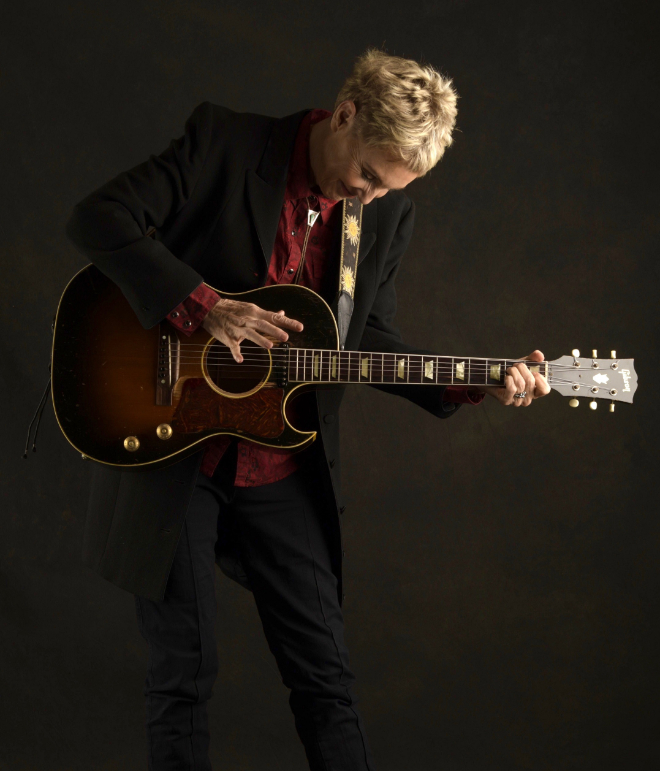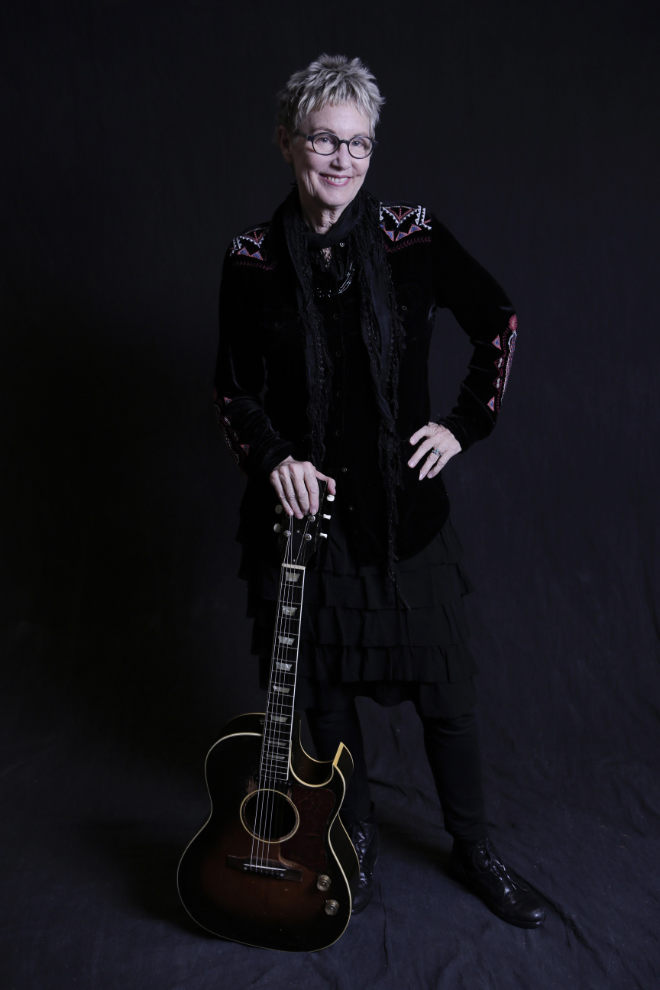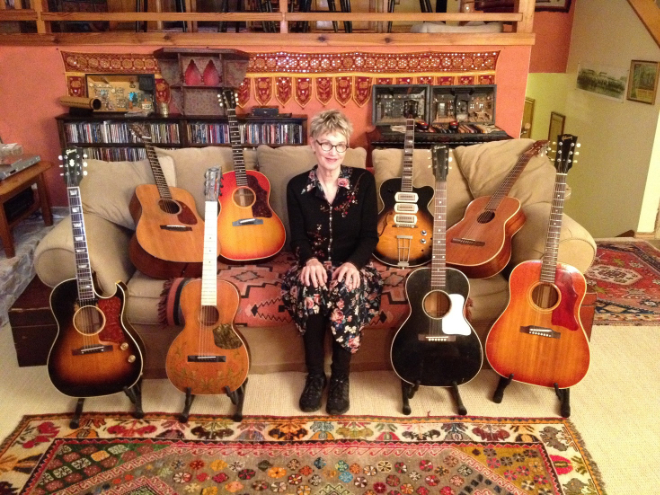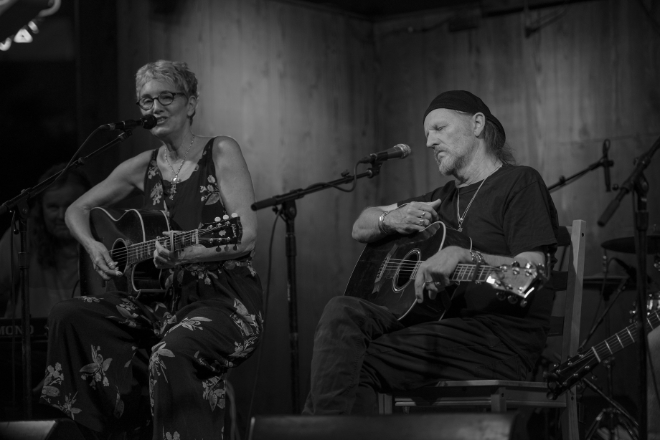Musician: ELIZA GILKYSON
Video: “At the Foot of the Mountain”
ELIZA GILKYSON FEATURED AT BLUE ROCK’S COOL NIGHTS 21 THIS THURSDAY, NOVEMBER 18
Eliza Gilkyson will be featured at Blue Rock aLive! Cool Nights 21 livestreaming concert series—this Thursday, November 18. She will be joined by the incredibly talented Mike Hardwick, who has played guitar on all her records.
Gilkyson’s latest release Songs from the River Wind is what she calls her “love letter to the Old West”—snapshots of the people and places, lives and loves lost and found over her years of wandering the West as a musical minstrel searching for her heart’s home.
Feeling the need to “take a little break from the socio-political music” she felt compelled to write for her last six releases, including her critically acclaimed political masterpiece “2020.” Concurrent with the hair-raising 2020 election cycle and the haphazard handling of COVID19 in Texas, the twice Grammy-nominated artist moved her base from Austin to Taos. She gathered a collection of songs written over the past 40 years that chronicle her travels and memories of characters and events that birthed her enduring love affair with the West, culminating in her recent decision to relocate permanently to Taos—sinking down deep roots at long last.
With cameos from Warren Hood on fiddle, Kym Warner on mandolin, and Michael Hearne on vocals, some old and new originals, some covers that fit the theme, and a few adaptations of several venerable old cowboy tunes, she went for the kind of Western/Folk sound that highlights her love of storytelling and true blue characters, her love of the rivers and the mountains, and her joyful return to the high desert plateau “at the foot of the Mountain” she now calls home.
Eliza Gilkyson’s passion for living life to the fullest is evidenced in her unparalleled and unwavering belief in social justice. She recaptures her sense of wonder and celebrates hope by dipping into the well of surrounding beauty—challenging us to open our eyes and discover what has been here all along.
Check out her livestream this Thursday, November 18, at Blue Rock Texas—where innovation, quality and creativity are evidenced in concerts produced with broadcast quality audio-video from their renowned Texas room—streamed straight to you. Inquire about a Season Pass ($105) which lets you can have a seat in the house—by sending in your headshot. What’s unique is they will place your headshot on a seat, so you will literally be sitting in the room. Go to: https://bluerocktexas.com/events

Eliza Gilkyson – Photo credit Robert Jensen
ELIZA GILKYSON Interview
with M Music & Musicians magazine publisher, Merlin David
Tell us about a song you will play at Blue Rock’s Cool Nights 21 (for your November 18 performance).
I wrote “Midnight Oil” in Austin a few years ago, before COVID and our recent relocation to Taos New Mexico. I was imagining at the time the moon coming up over Pueblo Peak in Taos and illuminating that gorgeous lush llano for which the mountain provides the water to make the orchards and fields flourish. The song morphed into a letter to the future and to my grandchildren, for whom tomorrow is so uncertain, so dangerous. I wanted them to know I was thinking of them, was worried for them, and to offer them some comfort that there will be a way through this madness that is overtaking our world.
Which song squeaked by and made it onto the new album Songs from the River Wind?
“Hill Behind This Town” was a last-minute add-on. It was written in the early 70s when I lived in an old wooden boxcar just off the train tracks in a little town outside of Santa Fe called Lamy, my first rental place. Such an innocent time—I thought maybe the song was too naive, but then I began to love the innocence of it and remembered how fun it was to have my whole life stretch out ahead of me. With the new record, I wanted to include the many aspects about being in the Southwest that I loved then, and still do. It was like recapturing my sense of wonder again. Plus it’s up-tempo, for a nice change.
What did you learn about yourself after recording this album?
I realized I had lost some of my joy in making music after finding myself living in nature again and singing about that. I have been so absorbed in politics and writing about current topics, I was digging myself into a hole of sadness. In hindsight, realized I needed to find my joy in the day-to-day again and let the music express that.
Eliza Gilkyson’s passion for living life to the fullest is evidenced in her unparalleled and unwavering belief in social justice. She recaptures her sense of wonder and celebrates hope by dipping into the well of surrounding beauty—challenging us to open our eyes and discover what has been here all along.
How did you get the idea for “At the Foot of the Mountain”?
The mountain itself speaks to me—I live at its feet. It provides the rain and snowmelt that feed this entire ecosystem around here. You develop a fondness for it that grows as the seasons change. Gratitude abounds. A sense of place is nurtured, along with a shared community of people who feel the same way.
What inspired you to go in this new direction?
I felt I had explored socio-political music in ways that pretty much covered the entrenched systems of power—capitalism, racism, patriarchy—and the ways that those hierarchies are kept in place, their effect on society, their effects on me personally and those I love. I have expressed it as best I can, and it was time to find the joy in living or I would not be able to get up in the morning. It was almost a survival tactic. Plus I was falling in love with the West again, having made this move. I wanted to celebrate my history here with these songs that pretty much describe my long-term love affair with this part of the world.

Eliza Gilkyson – Photo credit Rodney Bursiel
Who inspired you to write songs?
My Dad [Terry Gilkyson]. He was first and foremost a songwriter. His songs were hits and he wrote at home, so he was always around and very accessible. He wrote everything from little Christmas ditties to big hit songs. He had really cool guys in his band. So, I was hooked very early on.
Tell us about Terry Gilkyson’s “The Bare Necessities” (1967 Disney movie The Jungle Book.)
Honestly, that song was very much his philosophy—and his approach to life. He was complex and troubled, like any artist, and he had his dark side, but that song conveyed the best of him. He was not a materialist. He looked for the magic in the small things. He was totally tuned into nature. For him, nature was the manifestation of a supreme being. He saw nature as proof that there was a God, and that’s what he not only taught us but lived it and immersed us in it. That’s why that song speaks to so many people. It’s a very simple philosophy—looking for the simplest and most beautiful things in life, many of which are free. That’s him in a nutshell.
How did his views inspire you?
If somebody gives you a higher or rich, rewarding way of looking at things, it’s like they open a window for you. Once you’ve locked on to it—you won’t settle for less. Today, people search because they were never introduced to true, intimate love or a relationship with the natural world. If that window doesn’t get opened very early on, it’s a long process. I was very fortunate to have my Dad present in my life.
What songwriting tip would you like to offer?
Live a life that has meaning, depth, wonder and richness and write about that.

Eliza Gilkyson – Photo credit Jeff Fasano – Folk Alliance 2019
What instruments and equipment can you not live without?
My rig for performing is very different than what I have for writing at home. I’m a huge fan of vintage parlor guitars and old Gibsons. I love my guitars. I’m in love with them. Each one of them gets played a lot and they’re very dear to me. Some are perfect for recording, like my 1932 Gibson L-00 with the floating fingerboard—that’s the go-to on a lot of records. If you listen to “Midnight Oil” on The Nocturne Diaries, I play three guitars on that song. Also, there’s a guitar that took me years to find and I’m absolutely hooked on it—1951 Gibson CF-100E acoustic guitar (they made it from ’51-’58). It was their first attempt to make an acoustic guitar go electric using a P-90 pickup that was in hollow-body electric—warm coil tube sound. I’ve also installed an acoustic pickup so I can switch from acoustic to electric. With two different jacks, it has all these options. It’s a great looking, great-sounding guitar. Right now, I have three of them. (Laughs) I’m a big fan of the Highlander pickups. Seymour Duncan gave me his version of the P-90—that emulated it but didn’t have the hum. And I’m sold on those new G7th Capos. I use them exclusively.
Do you remember the first time you heard one of your songs on the radio?
Oh, my goodness—it was a big deal. When I was living in Santa Fe in the 70s, they played “The Lights of Santa Fe.” It was an incredible feeling. Then, when “Calling All Angels” came out in the late 80s in CA—that was huge. I’m still stoked when I hear my songs on the radio because there’s not a lot of radio for people like me. I almost still have to pull over and work through my freak-out. (Laughs)
Top 5 Musicians who inspired you to become a musician?
My Dad, first and foremost. Van Dyke Parks, who was in the second incarnation of my Dad’s band Easy Riders. He’s a dear friend—loved our Dad very much. They were very tight and did a lot of co-writing and co-producing. After that, it was a folk singer in Los Angeles, Carol Hedin. She was big in the folk circuit in those days. She Travis-picked—really good fingerpicker. She was a very dark, smoky, sad person. She had a deep voice and I was a low alto. She was a sorrowful, creative person who could really play and was a big influence on me. From afar, Joan Baez was important to me; later, Joni Mitchell; then, the folk rock movement with Bob Dylan and on out from there.

Eliza Gilkyson – Photo credit Rodney Bursiel
Tell us a “pinch me” moment.
In terms of my heroes, having Joan Baez cut two of my songs without having ever met—that just blew my mind. It was incredible to have that come full circle—really meaningful to me. And Van Dyke played on my record. He sat in at McCabe’s. I couldn’t believe this person that I’ve known all my life as a friend—and he added so much to my music.
What are your Top 5 favorite albums of all time?
Joan Baez—I listened to her stem to stern. Buffalo Springfield, first record. Early Steve Miller. Bob Dylan’s Blonde on Blonde. The first album that I ever bought was Phil Ochs’ I Ain’t Marching Anymore. Can you believe it? I saw my destiny and then forgot. (Laughs) I’d forgotten about it until years later when I met Sonny [Ochs], his sister, and I remembered that Phil’s album was the first record I bought. I listened to it all the time. I saw my future and spent 30 years getting back to it. (Laughs)
Best advice someone has given you.
Years ago, Tom Paxton said, “Eliza, I always liked your early work, but the stuff you’re writing now is a sign that you’ve kept at it.” He said somebody told him, “The best thing you can do is to get good at what you do, instead of resting on a laurel because you got to a certain level or certain notoriety. If you keep getting good at what you do, that’s a standard you have with yourself. If you constantly get better at what you do, it’s a lifelong journey.” It’s part of Tom’s philosophy.

Best advice you’d give upcoming musicians.
Finding your authentic voice is essential. A lot of people listen to what’s happening and adapt to what’s current. In the long run, it’s better for you to keep experimenting with who you are. Find your authentic voice. I spent a lot of time emulating other people and I lost my authenticity. Things didn’t start happening for me until much later in life, when I stripped everything down and determined who I really was and what I wanted to say. Also, don’t be afraid of critique. I gathered a team that helped me find my way. I trusted them to tell me what wasn’t working. You can’t live in a vacuum. You can tell if something’s working by playing songs out. Be honest with yourself. Grow a thick skin but stay vulnerable—take critiques and woodshed yourself—strip things back down. A real good song maybe only has one good line. Go back, take that one good line and start over. It’s really hard to do, but it’s what makes a long career. It’s what helps you get better.
When did that happen for you?
It was a record of mine called Redemption Road. It’s a very uneven record, but it was the first time I self-produced and I was really trying to find my voice and also find a proper production, which was no synthesizer or keyboards—only using organic instruments. It was important for me to get back to what served me best—melodically and production-wise.
Tell us a “pinch me” moment when you thought “Wow, this is really happening to me!”
When I had the Tosca String Quartet come in and do a live session on my song “Reunion”—it was hair-raising, soul satisfying, beyond description. It was for Secularia, my album of secular hymns. I call it spiritual music for atheists. Also, having Jimmy LaFave duet on “Down by the Riverside” just a few months before he couldn’t sing anymore. It was an incredibly special moment to have him sing “When I lay my burden down.” I’m overwhelmed just talking about it now.

Why is Blue Rock a special place for you?
They are friends of artists. So much care has gone into that place, so much support from Billy and Dodee Crockett and the fan base they have built. Great sound and visuals.
How do you remain hopeful in this strange and unique socio-political time?
I live and walk in beauty every day. I surround myself with people I trust and love, who love me. I have dogs. I grow food and harvest our orchard. I have good relations with my neighbors. I look for the small miracles that occur daily in my world.
Where can new fans get more info and stay updated?
www.ElizaGilkyson.com
Instagram: @elizagilkyson
Twitter: @elizagilkyson
Facebook.com/ElizaGilkyson1




comment closed